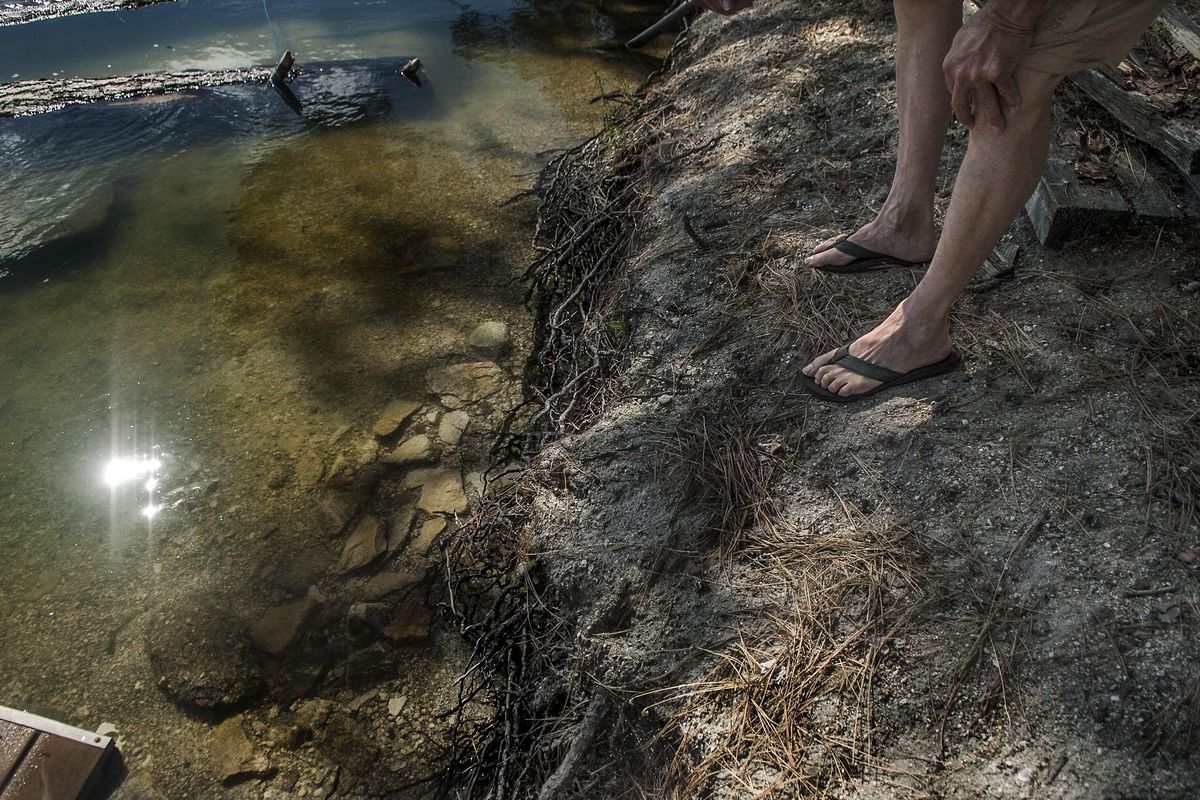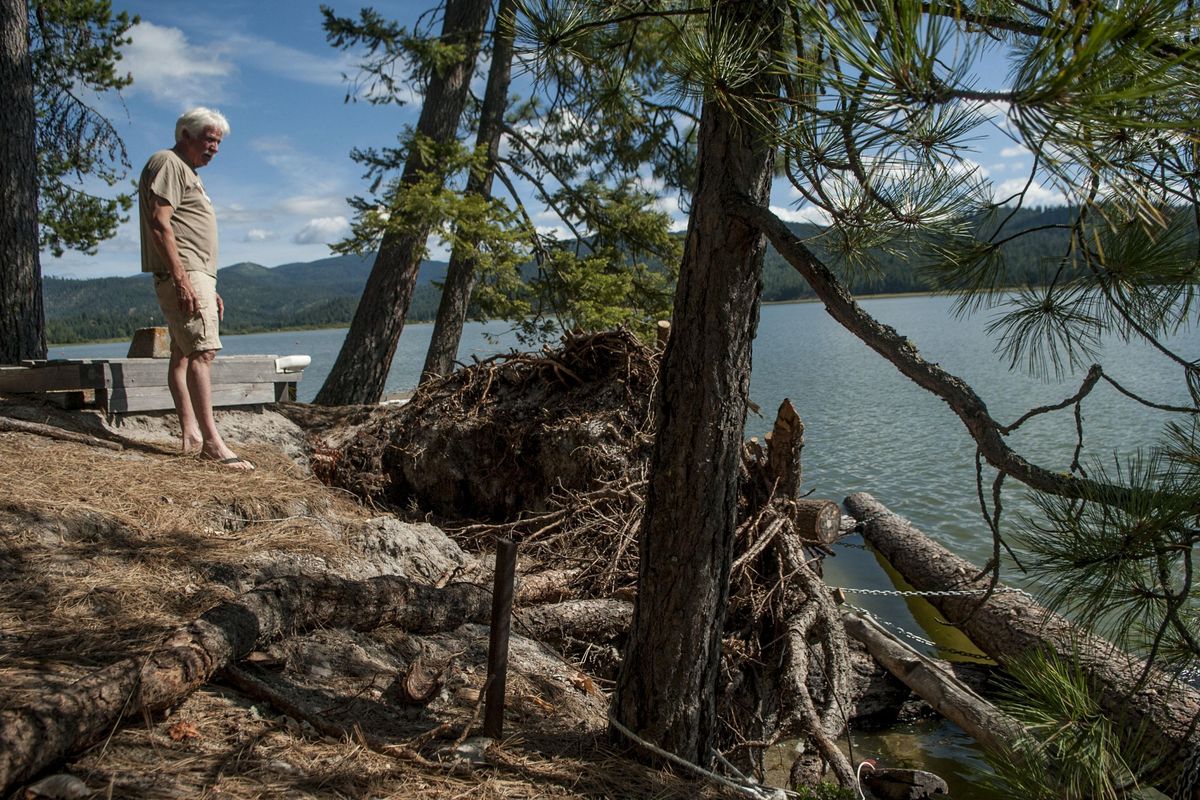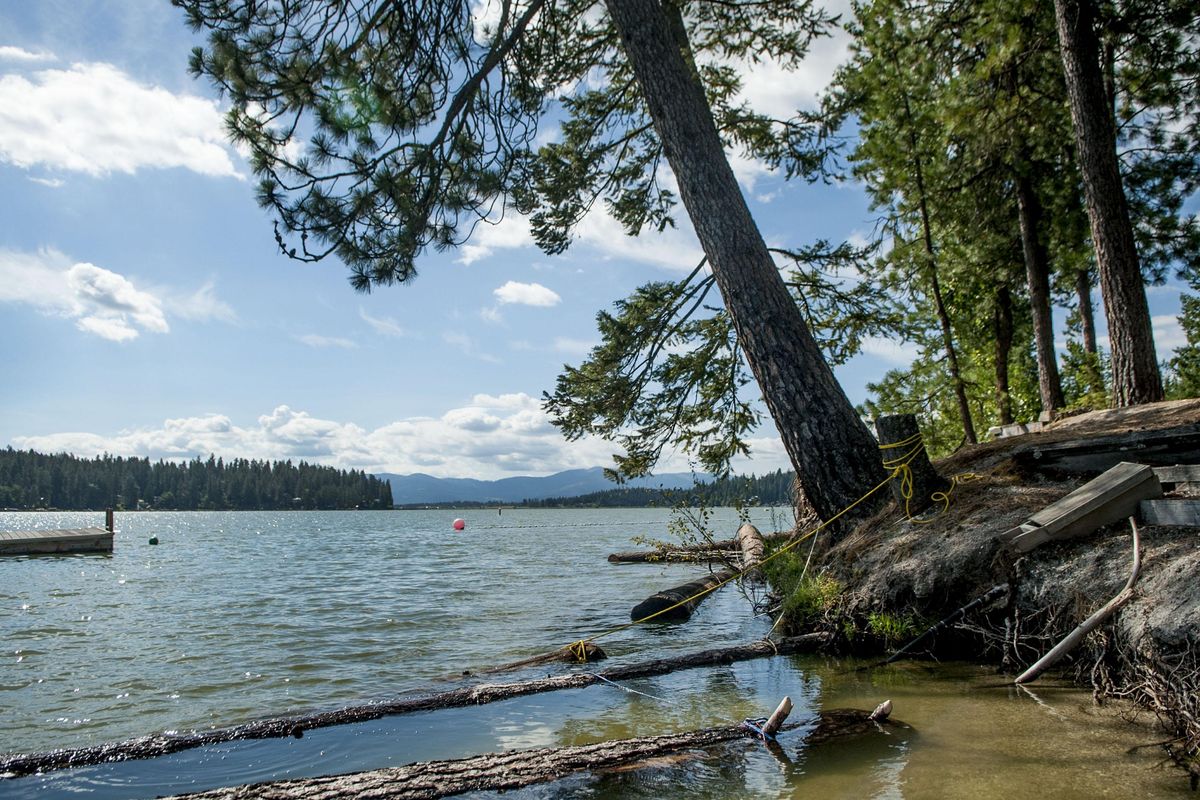Wake boats draw ire of property owners
“Everyone is just doing what they can,” said Dennis Rewinkel about shore damage on the northwest corner of Newman Lake. Rewinkel and members of Newman Lake Property Owners group are working to stop the erosion of the shore due mostly to boat traffic. (Kathy Plonka / The Spokesman-Review)Buy a print of this photo
Plowing the water may be one of the fastest growing sports of the boating industry, but the use of wake boats has also raised the ire of property owners, other lake users and those who enforce the rules of the waterways.
Wake boats, which are driving the resurgence of sales in the boating industry, work by sucking in gallons of water and shaping waves preferred by wake boarders and wake surfers, who especially like the slow-speed thrills behind the boat-generated waves.
“We call it the new tubing. I’ve taught over 5,000 people how to surf,” said Ricky Krieger, who works for Tobler Marina in Hayden. “It’s the most enjoyable, safest and fun sport to do.”
But try telling that to the property owners around Newman Lake. Dennis Rewinkel heads up a new group of property owners who are seeking a solution to many problems, including erosion.
“It certainly looks like a lot of fun,” Rewinkel said of wake surfing. “But (150-foot no wake zone) doesn’t really diminish a boat-generated wave all that much. I’ve had people tell me they lost a foot of bank just on that day, the Fourth of July.”
The use of the wake boats has become the number one enforcement issue for both Kootenai and Spokane County marine deputies. Some counties on the West side of Washington have even banned the ballast boats on certain waterways.
Spokane County Deputy Jim Ebel spent an entire day earlier this month calming upset property owners on the Spokane River near Millwood. A couple of neighbors bought ballast boats and have been using them in a channel that is so narrow that boats literally can only go on plane in one 16-foot wide channel in the middle to stay 100 feet away from both shores.
Several paddle boarders and kayakers launch from Boulder Beach and use the same waterways. They also have complained that boaters on the river have not slowed down, as is required, when they approach.
“That’s been consuming a lot of my days,” Ebel said of ballast boats. “I get it. It looks fun. It’s just hard on stuff. You put that much weight in a boat, you are talking about a 4 1/2 foot or a 5 foot wake. It’s unbelievable. You see boats going up and down and people are trying to hold on. It’s a problem. I wish there is more I could do about it, but it’s really difficult.”
All boaters in Washington are required to drop their speed to 5 mph or create no wake 150 feet from any shoreline or dock. In Idaho, the no-wake zone is actually larger – 200 feet – unless they are boating in the Spokane or Coeur d’Alene rivers, where the no-wake zone is 100 feet.
Both Kootenai County and Washington state, however, do have ordinances or laws that allow deputies to ticket boaters who create a wave that causes injury or property damage even if it was made outside the no-wake zone.
Lt. Stu Miller, of the Kootenai County Sheriff’s Marine Division, said his deputies have always had complaints about pleasure boaters and personal watercraft violating no-wake zones.
He’s worked with property owners on Lake Coeur d’Alene and the Idaho portion of the Spokane River and both groups have asked about banning wake boats in certain areas.
“Their biggest concern is that they are losing property every time someone throws a wake at it,” Miller said. “We do what we can to catch those folks who violate and are causing damage from their wake, but it’s a task. You usually have to be sitting there and watching it happen.”
The deputies often find themselves trying to solve what has become a property dispute between million-dollar home owners, who live on the water and use boats themselves, and those who want to use the water for the day.
“Where is that line? What rights do property owners have compared to those who recreate on the water?” Miller said. “It’s going to be difficult.”
Communication is key
For his part, Krieger, the boat salesman, said he takes every person who buys a ballast boat out and gives them a run through. A big part of that time is educating the boaters about where they can create the waves without impacting others.
“For those people who are trying to ban wake surfing, the only thing they are going to do is totally eliminate all water sports,” he said. “There is always something. It gets into a battle. Nothing is going to happen until people get educated.”
Krieger, who lives on Long Lake, said he and his father for years have had to rebuild their shoreline. But he said the top two causes of erosion are current and wind, which creates natural waves.
“We stay away from the shoreline. We like to ride where there is nobody,” he said. “Just go surf away from people’s docks. People need to be educated and use common courtesy.”
But Rewinkel said that’s easier to do on Long Lake than Newman Lake, which is only about 1,400 acres in size.
He relayed the story of running into a Long Lake resident the other day while buying some flooring at a local store.
“We asked them if they have problems with wake boats,” Rewinkel said. “They said, ‘Oh, we are having terrible problems.’ I think it’s a common problem.”
Ebel, who has been patrolling Newman Lake for most of the past four years, said he personally has seen advanced erosion around the lake.
“I can’t say that it’s all from the ballast boats, but it appears over the last four years of patrolling Newman Lake that there is a lot more root exposure,” he said.
Rewinkel said the shoreline problem is compounded because property owners face a long delay in getting county and state approval to build anything to protect shoreline.
“Shoreline erosion … is getting worse at an exponential rate,” he said. “People say they have lost more beach in the last year than they have in the last 10 years.”
But, Rewinkel said he understands that he lives on a lake that has a public dock, meaning virtually anyone can come recreate on the waters, but that only a few landowners pay a special tax to maintain water quality.
“If you look at the wake surfing blogs on the Internet, there are several responsible people,” he said. “They are aware, as well, that if they don’t start working with people on the lake that they are going to get kicked out of everywhere. I don’t think this is a secret. We just haven’t gotten together and figured it out.”
Krieger said part of the problem has come in changing technology. A lot of the boats built prior to 2012 required boat operators to turn huge circles to create a good wave. The newer boats, which can cost between $150,000 and $200,000, only create the perfect wave when they travel in a straight line.
“I have customers who come up to me and say, ‘You are the jackass out there ruining our shorelines,’ ” Krieger said. “It’s part of living on the lake. I understand. I try to educate them as much as I can. We need to communicate in a civil manner.”



